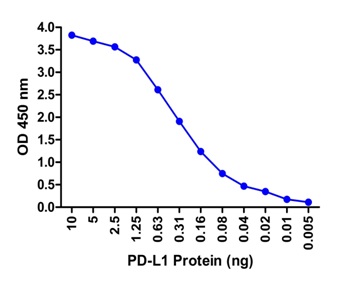PDL1 Antibody [8E12] (biotin)
| Code | Size | Price |
|---|
| PSI-RF16032-biotin-0.02mg | 0.02mg | £150.00 |
Quantity:
| PSI-RF16032-biotin-0.1mg | 0.1mg | £515.00 |
Quantity:
Prices exclude any Taxes / VAT
Overview
Host Type: Mouse
Antibody Isotype: IgG1
Antibody Clonality: Monoclonal
Antibody Clone: [8E12]
Regulatory Status: RUO
Target Species: Human
Shipping:
blue ice
Storage:
PD-L1 antibody can be stored at 4˚C for three months and -20˚C, stable for up to one year. As with all antibodies care should be taken to avoid repeated freeze thaw cycles. Antibodies should not be exposed to prolonged high temperatures.
Images
Documents
Further Information
Additional Names:
PD-L1 Antibody: Programmed cell death 1 ligand-1, programmed death ligand 1, PDL1, PDL-1, B7-H1
Application Note:
PD-L1 antibody can be used for as detection antibody in Sandwich Elisa at 1 μg/mL.
Background:
PD-L1 Antibody: Cell-mediated immune responses are initiated by T lymphocytes that are themselves stimulated by cognate peptides bound to MHC molecules on antigen-presenting cells (APC) (1). T-cell activation is generally self-limited as activated T cells express receptors such as PD-1 (also known as PDCD-1) that mediate inhibitory signals from the APC (2). PD-1 can bind two different but related ligands, PD-L1 and PD-L2. PD-L1 is a B7-related protein that inhibits cell-mediated immune responses by reducing the secretion of IL-2 and IL-10 from memory T cells (3). This suggests that PD-L1 may be useful in reducing allogenic CD4+ memory T-cell responses to endothelial cells, thereby reducing the likelihood of host immune responses to allografts. PD-L1 also functions as an immune checkpoint protein, and multiple anti-PD-L1 antibodies are currently in phase II and III clinical trials, with one antibody already approved for the treatment of cancer (4).
Background References:
- Holling TM, Schooten E, and van Den Elsing PJ. Function and regulation of MHC class II molecules in T-lymphocytes: of mice and men. Hum. Immunol. 2004; 65:282-90.
- Ishida Y, Agata Y, Shibahara K, et al. Induced expression of PD-1, a novel member of the immunoglobulin gene superfamily, upon programmed cell death. EMBO J. 1992; 11:3887-95.
- LaGier J and Pober JS. Immune accessory functions of human endothelial cells are modulated by overexpression of B7-H1 (PDL1). Hum. Immunol. 2006; 67:568-78.
- Aydin AM, Woldu SL, Hutchinson RC, et al. Spotlight on atezolizumab and its potential in the treatment of advanced urothelial bladder cancer.Onco. Targets Ther. 2017;10:1487-502.
Buffer:
PD-L1 Antibody is supplied in PBS containing 1% BSA and 0.02% sodium azide.
Concentration:
1 mg/mL
Conjugate:
biotin
DISCLAIMER:
Optimal dilutions/concentrations should be determined by the end user. The information provided is a guideline for product use. This product is for research use only.
Immunogen:
PD-L1 antibody was raised against the extracellular domain of human PD-L1.
NCBI Gene ID #:
29126
NCBI Official Name:
programmed cell death 1 ligand
NCBI Official Symbol:
CD274
NCBI Organism:
Homo sapiens
Physical State:
Liquid
Protein Accession #:
NP_054862
Protein GI Number:
7661534
Purification:
PD-L1 Antibody is supplied as protein A purified IgG1.
Research Area:
Immunology
Swissprot #:
Q9NZQ7
User NOte:
Optimal dilutions for each application to be determined by the researcher.



